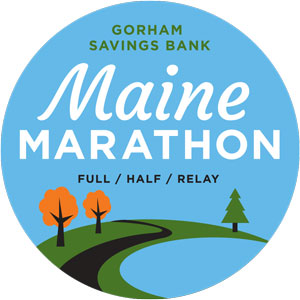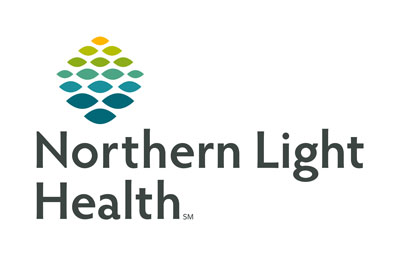An Enduring Good
The Gorham Savings Bank Maine Marathon has generated more than $5.2 million for local charities and done so much more.
When Gretchen Spann crossed the finish line of the Gorham Savings Bank Maine Half Marathon back in 2010, the fact that she’d pushed her body farther and faster than it had ever gone was practically an afterthought. The 13.1-mile run, and the hundreds of sweaty, pre-dawn miles she’d logged to prepare for it, offered a release from the stress that had mounted during the two-and-a-half years her 7-year-old daughter had battled and recovered from acute lymphoblastic leukemia. Spann’s daily training plan — and the goal on the horizon — was a balm that helped allay her fears about relapse and long-term side effects.
“It was something I could control,” she says, “which was so therapeutic coming out of a situation in which I felt so powerless.”
The race also offered a way for Spann to raise money and awareness for the Maine Children’s Cancer Program, which provided critical emotional support during her daughter’s treatment. Through its training team and direct donations, the event has raised nearly $350,000 for the organization over the past decade.

The Maine Children’s Cancer Program is one of dozens of local nonprofit groups that has benefited from the Maine Marathon. The 29-year-old event, which includes a marathon, half-marathon, and relay, has raised more than $5.2 million for more than 50 local organizations and become a powerful vehicle for good in the Pine Tree State. The organization donates 40 percent of gross revenues each year. An ever-expanding roster of sponsors, including Gorham Savings Bank, Poland Spring, and WEX, helps cover costs. More than 900 volunteers help produce the event, which sees thousands of runners taking to an out-and-back course that begins and ends at Portland’s Back Cove the first weekend of October. Volunteer race director Bob Dunfey has tripled sponsorship income in the past three years and continues to recruit more sponsors and runners to keep growing the impact.
“There is so much need in our community, and so many incredible small organizations scrambling to meet it,” says Dunfey. “This event has provided a way for thousands of people to support all those worthy causes, and improve their own health along the way.”
In 2017, the race donated $50,000 to the Cromwell Center for Disabilities Awareness, helping the nonprofit bring programs to 10,000 students in 560 classrooms throughout the state. “That money directly gives us the ability to say yes to more requests from schools,” says Susan Greenwood, executive director of the Portland-based organization. “In the past, we had to say no because we just didn’t have the funds.”

The impact of the marathon is amplified by the fundraising efforts of individual runners, who form training teams for the event.
More than two dozen people ran the relay on behalf of Portland Community Squash last year, raising $10,000 for the organization that, along with the $6,700 donation from the race, funded scholarships allowing eight students to attend their year-round programs, which include squash, wellness, intensive academic support, STEM lessons, and more.
Those funds are critical, since the organization had to deploy its staff to do remote academic sessions and wellness work during the shutdown.
“Being part of the Maine Marathon definitely raised our visibility around the community, and helped us reach beyond our typical fundraising circles,” operations director Sarah Stickney says.
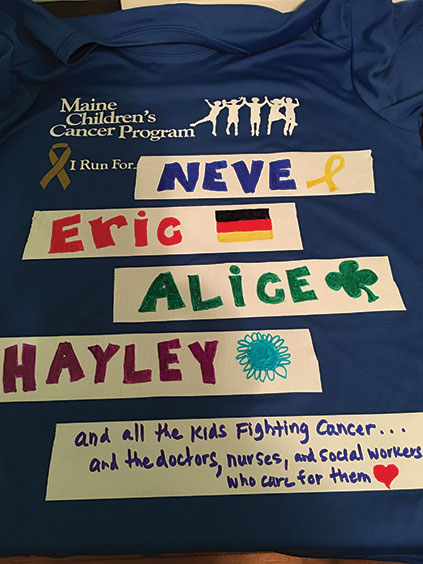
$5.2
million raised for local nonprofits
50
organizations have benefited
900
volunteers
40%
of revenues donated to Maine charities
Above: Gretchen Spann’s race shirt raises awareness for the Maine Children’s Cancer Program, where her daughter was treated. Courtesy of Gretchen Spann.
Though the marathon pivoted to a virtual format this year due to COVID, more than 650 people completed the distance on their own, uploading their mileage to an app. They include Amy Porter, who ran 26.2 miles for the first time without much of the traditional marathon fanfare. During training, she worked toward a goal of raising $1,000 for The Jimmy Fund, a Boston-based organization that supports the Dana-Farber Cancer Institute, where her cousin was treated.
“Running has provided a way that I can make a difference,” she says. “And I’m so grateful for that.”
That feeling has kept Spann involved in the race for a decade, even as her daughter is now a healthy 17-year-old who serves as starting goalie for her soccer and lacrosse teams. Spann captains the Maine Children’s Cancer Program fundraising and training team, which has grown to 65 people.
“The race created this space where people who are impacted by these illnesses can come together to do something positive and support one another,” she says. “And that’s been so healing.”
Visit mainemarathon.com to learn more.
Safe Haven
Boys & Girls Clubs of Kennebec Valley provides a vital support system to kids and seniors.
By the time he reached the eighth grade, Tookie Gregoire’s life seemed to be spiraling downward fast. Many days, he didn’t know where he’d get his next meal. Some nights, he slept outside because he didn’t have anywhere else to go. Though he moved into a foster home before his freshman year at Gardiner Area High School, he still felt lost.
“I didn’t have any stability in my life,” Gregoire says. “I was a Black male in an all-white community. I was in the foster system. All the odds were against me.”
Those odds changed once he started spending time at the Boys & Girls Clubs of Kennebec Valley. The club provided a safe place where Gregoire could hang out with friends before lacrosse practice and get nourishing food when he was hungry. Club staffers quickly became his support system. They cheered him on at every home game. They helped him complete his college applications. And they were the first people he told when he was accepted to St. Joseph’s College.
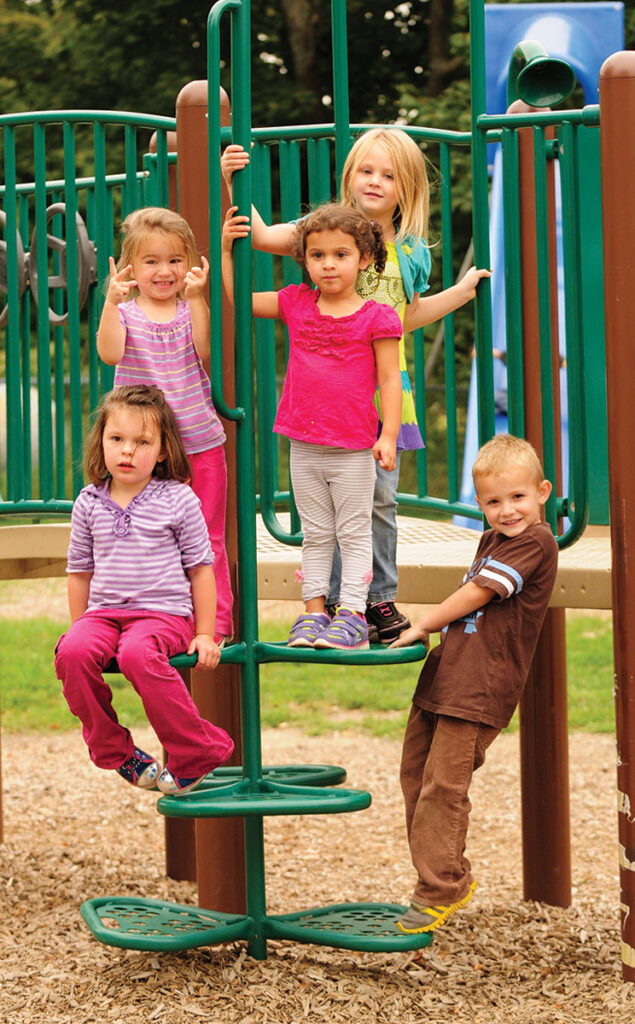


“They took on the roles of parents and big brothers and sisters I’d never had,” says Gregoire, now 31 and working as a recruiter for the National Guard. “They kept me from being another statistic.”
Gregoire is one of more than 20,000 youth for whom the Boys & Girls Clubs of Kennebec Valley has provided a critical lifeline since it was founded in 1999 as an after-school childcare program. The organization now offers summer camps, sports leagues, tutoring, programs for teens and seniors, and meals for kids who qualify for free or reduced-price lunches. It also provides leadership training to help teens graduate from high school on time with the skills they need to enter college or the working world.
“The need continues to grow, not just for the
activities, mentorship, and meals we offer, but also for the safety, warmth, and care our
dedicated staff provides.”
$1 million
meals and snacks served to kids who qualify for free or reduced-price lunch
20,000
kids impacted through childcare, youth sports, and teen programming since 1999
56%
of kids come from families with incomes at or below the federal poverty level
Boys & Girls Clubs is now raising $10 million to build a new clubhouse to expand programs, shorten its waiting lists, and replace the 64-year-old former school where it is based. “What began as a small childcare program has grown into a support system that families throughout the region have come to rely on,” chief executive Ingrid Stanchfield says. “The need continues to grow, not just for the activities, mentorship, and the meals we offer, but also for the safety, warmth, and care that our dedicated staff provides. Having a new clubhouse will make the work we do even stronger.”
Visit bgckv.org to learn more about Boys & Girls Clubs of Kennebec Valley and support its Great Futures Campaign.
Help for the Hungry
As food insecurity soars during the pandemic, Good Shepherd Food Bank rushes to nourish vulnerable Mainers.
When the pandemic forced Maine into lockdown in March, Good Shepherd Food Bank immediately felt the impact. Thousands of Maine families turned to food pantries around the state for canned foods and household essentials like toilet paper. “We saw a huge spike in demand. We couldn’t get the food we needed. Vendors were backed up for weeks and couldn’t fulfill orders,” says Kristen Miale, president of Maine’s largest hunger-relief organization, which supplies more than 500 food pantries, shelters, senior centers, and schools throughout Maine. In April, the Food Bank bought $850,000 in Hannaford gift cards for its partner agencies, because it didn’t have enough non-perishable food to distribute.




Bare shelves are just one new pressure that COVID has put on Good Shepherd Food Bank. Donations from retailers, which make up about 70 percent of the Food Bank’s inventory, dropped by 15 percent in April as stores scrambled to keep their shelves stocked. The Food Bank awarded $1.2 million to community food pantries, about six times more than a typical year, to help them pay for PPE, home-delivery services, and tents for outdoor distribution. “Food pantries, many of which are managed by volunteers, had to make unbelievable changes,” Miale says, “and they had to do it quickly.”
Despite the challenges, the Food Bank distributed 29.3 million meals last year, about 4 million more than a typical year. Looking ahead, the organization is preparing for a 25 percent increase in demand as the fallout from the pandemic continues. It will increase grants to partner food agencies in the year ahead and buy more fresh produce from local farmers through its Mainers Feeding Mainers program. Those farmers, who have seen demand plummet from restaurants and educational institutions, are more reliant than ever on purchases from the Food Bank.
170,000
Mainers face food insecurity — which means they don’t have consistent
access to enough nutritious food
for an active, healthy life
500
nonprofit partner agencies — including food pantries, meal sites, shelters, senior centers, schools, and healthcare centers — provide food from Good Shepherd
Food Bank to people in need
45,302
emergency food boxes
packed with the help of L.L.Bean
29.3 million
meals distributed
by Good Shepherd Food Bank last year, 4 million more
than the
previous year
25%
increase in food
distribution
compared to
pre-pandemic levels
$1.2 million
in grants to community food pantries to help them maintain operations during the pandemic
Support from individuals, foundations, and corporate donors has grown during the outbreak. Miale just hopes that when the public health crisis ends, people remember that Maine’s food insecurity crisis remains.
“The pandemic put a magnifying glass on problems — especially around our most vulnerable community members like seniors, kids, and people of color,” Miale says. “They were struggling before. Now they’re experiencing higher rates of infection and food insecurity. These disparities won’t go away once COVID does. We hope this is a wake-up call that we need to do a better job of supporting all these marginalized communities.”
Visit gsfb.org to find a Good Shepherd Food Bank partner near you.
Green Day
With a lift from Hancock Lumber, The Ecology School creates a groundbreaking new model of conservation in action.
In 1998, The Ecology School opened as a small seasonal environmental education center at a rented camp on Saco’s Ferry Beach, where school groups and families came to learn about how coastal ecosystems work. In the more than two decades since, the nonprofit has blossomed into a force of nature. Each year, more than 12,000 kids and adults from all over the country flock to The Ecology School to learn about sustainability, conservation, and how plants, animals, and people are connected with our natural surroundings.
Now, The Ecology School is building a permanent home at River Bend Farm, a 105-acre expanse along the Saco River with forests, fields, ponds, and 3 miles of trails. The move will allow the organization to provide a broader range of year-round environmental and STEM programs to individuals, schools, and community organizations, and expand its curriculum to include farming, climate resilience, and local food systems.
The new campus, which is set to open in January, will offer a groundbreaking new model of sustainability.
“Every feature is designed to show, not just tell, how humans can have a positive impact on the ecosystems that we rely on,” says Drew Dumsch, chief executive officer and co-founder of The Ecology School. The $14 million project will feature new dorms and dining commons that meet the world’s most rigorous green building standards, the Living Building Challenge.
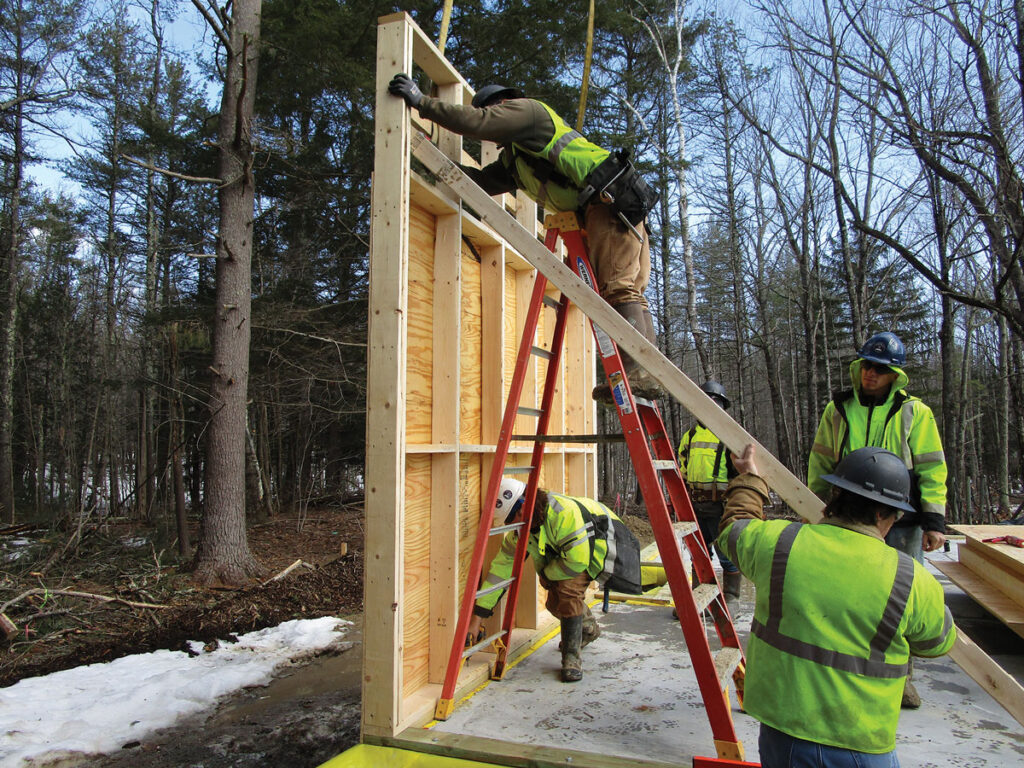

More than 700 solar panels on-site will generate 105% of the school’s energy needs, so the buildings will put more power back onto the grid than they use. The kitchen will be outfitted with energy-efficient electric appliances, while low-flow toilets, faucets, and showers will conserve water. Rain gardens will capture stormwater runoff, so it can be reused to water the gardens. Nearly all the produce served in the dining commons will be grown on the farm, in permaculture gardens that have been designed to restore soil, conserve water, and redirect waste. All of the siding, trim, and strapping materials for the new buildings, which were supplied by Hancock Lumber, are locally grown white pine that’s been certified by the Forest Stewardship Council, a designation for wood that’s harvested from forests that are responsibly managed, socially beneficial, environmentally conscious, and economically viable. Hancock also sourced and supplied all the FSC-certified framing material, including its own made-in Maine wall panels and roof trusses.
“Hancock Lumber is proud to supply products that our employees manufactured right here in Maine for facilities that will meet the high standards of the Living Building Challenge,” says Paul Wainman, president of Hancock Lumber, which recently opened a store in Saco. “It’s so special to be part of this exciting initiative.”
Visit theecologyschool.org to learn more.
Better Now
In the wake of COVID-19, getting routine care at Northern Light Health is more convenient than ever.
Like just about anything else these days, going to the doctor for a checkup is a radically different experience than it was before COVID-19. And that’s not necessarily a bad thing. In fact, many of the changes Northern Light Health has made during the public health crisis have made routine visits much easier.
“The pandemic forced us to offer more tailored care, but these changes benefit everyone,” says Dr. James Jarvis, director of clinical education at Northern Light Eastern Maine Medical Center in Bangor. And getting that care has never been more important, especially for those who’ve been delaying it because they haven’t felt safe coming in.
“From diabetes to cancer, there are so many illnesses that can be prevented and managed with regular screenings,” Jarvis says. “It doesn’t do much good to avoid COVID-19 and delaying treatment, then to die later of a disease you could have detected early.”


At Northern Light Health, patients see more details about sanitation protocols and signs that indicate “this room has just been cleaned,” similar to a hotel. “We’re conscious of the fact that people need to see all the precautions so they feel safe getting care,” Jarvis says. Courtesy of Northern Light Health.
Now, Northern Light Health is offering telehealth visits to primary care doctors and many specialists instead of office visits. “Often, the physical exam is of limited use,” Jarvis says. “Doctors can get the most important information by discussing things like symptoms, medications, diet, and exercise.”
Patients will also spend less time in line. To limit the number of people in reception areas, Northern Light has expedited check-in and checkout, updating patients’ insurance details over the phone before visits, and making follow-up appointments from the exam room.
Northern Light Health is a statewide healthcare system with 10 hospitals, primary and specialty care practices, and pharmacy, laboratory, and other services throughout Maine.
Curbside service is also likely to be a permanent part of health care going forward. In the spring, Northern Light Health made routine childhood vaccinations available on a drive-through basis. Keeping shots up to date is particularly important since many of the illnesses vaccines prevent, like the flu and whooping cough, mimic those of COVID-19.
Even after a safe vaccine becomes widely available, plexiglass barriers and reminders to stay 6 feet apart are probably here to stay. That will help stop the spread of COVID-19 and many other airborne illnesses that spread when people sneeze, cough, laugh, and talk. “It’s critically important as the weather gets colder and we move activity indoors,” Jarvis says. “We don’t want to see a second wave.”




